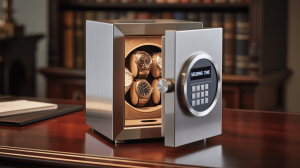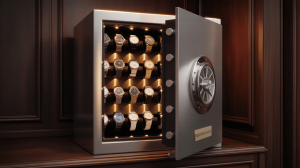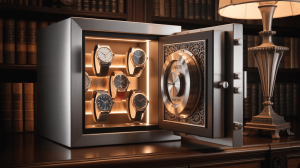Safe for Watches: Keeping Your Collection Secure and Stylish. But here’s the kicker… Your watch collection deserves protection that’s as refined as their craftsmanship. A dedicated watch safe blends robust security, climate control, and elegant design to safeguard every piece.
1. Why a Watch Safe Is Essential
A specialized watch safe uses reinforced steel walls and thick locking bolts to deter theft. Precision locks—whether mechanical dials, electronic keypads, or biometric scanners—ensure only you can access your collection. Concealed anchor points let you bolt the safe into floors or furniture, preventing removal. Insurance providers often require certified safes for high‑value collections and may reduce premiums in return.
| Feature | Function | Benefit |
|---|---|---|
| Reinforced Steel | Resists drilling and prying | High physical protection |
| Precision Locking | Dial, keypad, biometric options | Tailored, secure access |
| Concealed Anchoring | Floor or furniture bolt points | Prevents theft by removal |
2. Evaluating Burglary Ratings
Burglary certifications like UL RSC or ETL guarantee a minimum forced‑entry resistance. A UL RSC safe must withstand common attack tools for at least five minutes. Electronic locks with time‑delay settings or dual‑lock configurations further slow intruders. Match the rating to the perceived risk in your area and the value of your collection.
3. Fire and Heat Protection Basics
Even a small fire can ruin lubricants and delicate mechanisms. Look for UL 72 Class 350 ratings—30 minutes at 1,200 °F or higher. Insulating materials such as gypsum or ceramic composites prevent internal temperatures from exceeding 350 °F. Expandable gaskets seal door seams against smoke and flames. Balance fire rating with safe size, as higher ratings often add weight.
4. Measuring Size and Capacity
Determine the number of watches plus straps, tools, and paperwork you need to store. Account for pillow height (1.5–2 inches) and clearance for winders. Compact safes (e.g. 6×8×6 inches) hold 2–4 watches; medium (8×10×8) holds 4–6; larger (10×12×8) accommodates 6–10. A snug interior prevents items from shifting, enhancing security.
| Dimensions (W×D×H) | Watch Capacity | Extra Storage |
|---|---|---|
| 6×8×6 in | 2–4 | Tools or straps |
| 8×10×8 in | 4–6 | Small accessories |
| 10×12×8 in | 6–10 | Full watch kits |
5. Selecting Exterior Materials
Choose a safe shell that complements your decor. Matte powder‑coat steel offers stealth and durability. Brushed stainless steel gives a modern look, while wood veneer or leather wraps lend warmth and luxury. Ensure materials resist corrosion and scratches, especially in humid environments.
6. Choosing the Right Lock Mechanism
Mechanical dials never need power, though they can be slower. Electronic keypads let you program multiple user codes and time delays. Biometric scanners unlock with a fingerprint in seconds but require power and occasional re‑enrollment. Dual‑lock systems combine two methods—such as keypad plus key—for layered security.
7. Integrating Watch Winder Features
Automatic watches need movement. Built‑in winders with adjustable turns‑per‑day (TPD) and rotation directions (CW, CCW, or bi‑directional) keep movements running. Quiet motors (< 25 dB) avoid noise, and pause settings prevent over‑winding. Removable winder trays convert to static storage when you prefer a non‑winding configuration.
| Winder Feature | Specification | Benefit |
|---|---|---|
| Adjustable TPD | Up to 2,000 turns/day | Matches manufacturer specs |
| Direction Control | CW, CCW, bi‑directional | Prevents mainspring stress |
| Noise Level | Under 25 dB | Silent home or office use |
8. Organizing the Interior
A structured interior protects and displays your collection. Foam or velvet‑lined pillows cradle each watch. Adjustable trays let you tailor spacing, while hidden compartments beneath trays store straps, cleaning tools, and documentation. Well‑designed layouts prevent scratching and streamline rotation.
9. Climate and Humidity Management
Leather straps and metal movements require stable humidity. IP54‑rated door seals block dust and light moisture. Desiccant packs or built‑in silica gel chambers maintain relative humidity below 50%. Some safes include digital hygrometers for real‑time monitoring and active dehumidifier modules for precise control.
10. Ease of Access and Backup Options
Convenience matters. Electronic keypads and biometrics provide instant entry. Time‑delay settings deter forced entry. Always have manual override solutions: hidden mechanical keys or dials ensure you can open the safe even if power fails or codes are forgotten.
| Access Method | Speed | Reliability |
|---|---|---|
| Electronic Keypad | Fast | Needs backup in power loss |
| Biometric Scanner | Instant | Requires re‑enrollment |
| Mechanical Dial | Manual | Battery‑free |
11. Noise and Vibration Considerations
Winders and locking bolts can generate noise. Rubber‑dampened motor mounts absorb vibration, while precision motors keep noise under 25 dB. Soft‑close hinges prevent door slams. Verify decibel ratings and user reviews to ensure whisper‑quiet operation in bedrooms or offices.
12. Smart Connectivity Features
Modern safes connect via Bluetooth or Wi‑Fi to send tamper, door‑open, and low‑battery alerts to your smartphone. Apps allow remote lock/unlock, TPD adjustments, and audit-log reviews—enhancing security whether you’re home or away.
| Smart Feature | Functionality | Advantage |
|---|---|---|
| Tamper Alerts | Instant notifications | Immediate security awareness |
| Remote Control | App-based lock/unlock | Convenience |
| Audit Logs | Records access events | Track user entry |
13. Power and Backup Power Strategies
Electronic locks and winders need reliable power. Choose safes with dual‑power support: AC adapters for daily use and rechargeable battery packs for backup. Low‑battery alerts—via LEDs or app notifications—prevent shutdowns. Always keep a hidden manual override key or code for emergencies.
14. Matching Style with Décor
Your watch safe should complement its space. Matte finishes suit minimalist rooms; wood veneers or leather wraps add warmth. Slim profiles fit nightstands or desks discreetly. Custom color or engraving options let you personalize the safe as a design feature.
15. Budgeting and Value Considerations
Entry‑level watch safes ($100–$300) provide basic security and key locks. Mid‑range models ($300–$700) add fire ratings, electronic locks, and basic winders. Premium safes ($700+) feature biometrics, smart connectivity, luxury finishes, and extended warranties. Prioritize core certifications and interior needs before extras.
Conclusion
A watch safe that marries security with elegance protects your collection and enhances your decor. Ready for the good part? Use this guide to choose a certified, feature-rich safe that keeps your watches secure, climate-controlled, and stylishly displayed.
FAQ
Q1: What burglary rating should I seek?
Aim for UL RSC or ETL certification for proven forced‑entry resistance.
Q2: How often replace desiccant packs?
Replace every 6–12 months based on local humidity.
Q3: Are biometric locks reliable?
Yes—premium scanners include encrypted templates and backup options.
Q4: Do smart features require subscriptions?
Basic app control is typically free; advanced monitoring may incur fees.
Q5: Is professional installation necessary?
DIY anchoring to studs suffices if you follow manufacturer guidelines.







